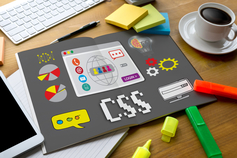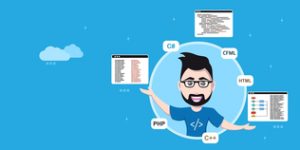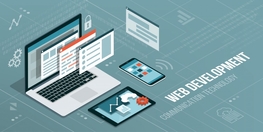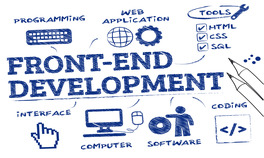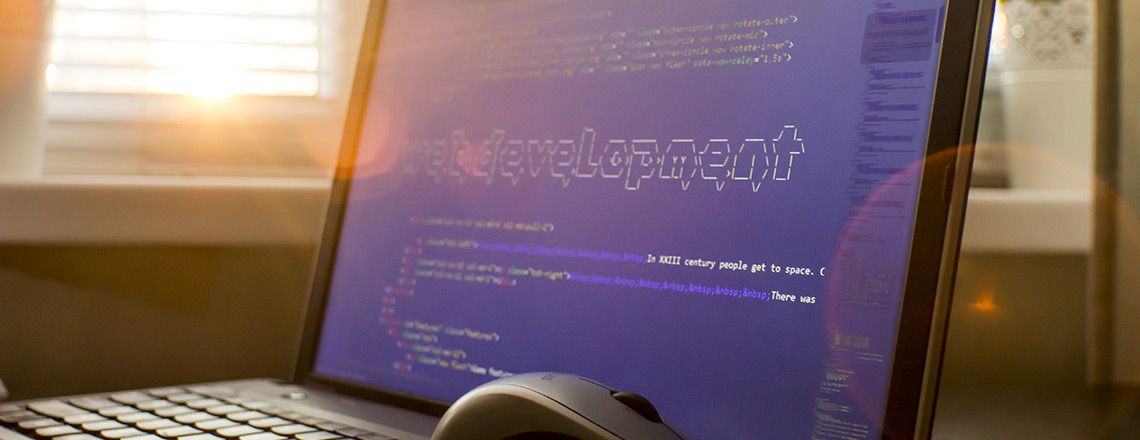
Launching a career in web development can seem almost overwhelmingly tricky. There are countless languages and tools to learn — for a beginner, even figuring out where to start learning can seem difficult.
But in practice, the process probably won’t be as complicated as you think. Once you have an idea of what skills you need to have as an entry-level web developer, you’ll be able to build your academic foundation in short order.
Want to know how to learn web development? We’re here to help. This article is for anyone interested in entering the web development field or looking to grow their existing skill set. It will cover some basic terminology, web development specializations and the tools and skills you’ll need to develop and manage websites. In other words, it’ll walk you through everything you need to know to kickstart your career.
Let’s get started!
Why Learn Web Development?
In short, job potential.
Web development is a quickly growing profession. The U.S. Bureau of Labor Statistics forecasts 8 percent growth for web developer jobs between 2019 and 2029. Web developers can freelance or work as internal employees within a company, and many work remotely. In short, it’s a great field for anyone who values professional growth and learning opportunities.
Skills covered in these tutorials:
- HTML
- CSS
- Python
- JavaScript
- Node.js
- SQL Databases
7 Steps to Learn Web Development
We’re going to go through everything you need to learn about the fundamentals of web development, from the nitty-gritty details of how websites work to high-level design concepts.
1. Web Development 101: How Do Websites Work?
At the most basic level, websites are collections of files and code stored on a server, which is connected to the internet. You access a website by loading it through a browser (e.g., Chrome, Firefox, Safari), also known as the client. This pair constitutes the “server-client model.”
Let’s consider how this works in action: let’s say your friend sends you a link to a funny video. When you click on the link, your web browser (the client) sends a request to the video website (the server) asking for the video file. The website’s server receives the request and sends the file to your computer.
The client-side and server-side are referred to as the “front end” and the “back end,” respectively. Front end web developers focus on a website’s client-side functions, while back end web developers focus on a website’s server-side development. Full stack developers work with just that — the “full stack” of development technologies — and have mastery of both front and back end technologies.
Understanding the differences between each can help you decide which of the three you would like to specialize in during your career. Now, let’s cover the differences between front end, back end and full stack web development.
What Is Front End Development?
Front end developers create the content you see when interacting with a website. This includes visual elements such as menus, buttons and animations that can execute on a client’s machine. Front end developers use three primary languages: HTML to create a website’s structure, CSS to change how a website looks and JavaScript to create interactive elements.
What Is Back End Development?
Back end developers work with the server side of a website. This involves managing web servers, interacting with databases and using data analysis — all of which are functions the user doesn’t see when interacting with the site. Back end developers may also use data-focused technologies like SQL and Python to manage a website’s functionality.
What Is a Full Stack Web Developer?
Full stack developers are experts in the “full stack” of website-related technologies.
If you’re wondering how long it takes to become a full stack developer, don’t worry; stepping into this versatile role is easier than you might think. With a full-time bootcamp, dedicated tech enthusiasts can accumulate job-ready skills in as little as three to six months. That said, those who prefer the comprehensiveness a formal degree provides should be prepared to set aside four or more years for their education.
Duties and Responsibilities of a Full Stack Developer
Full stack web developers are tasked with several website-related tasks. These commonly include, but are not limited to:
- Developing front end website design
- Understanding user interface and user experience design
- Writing technical documentation
- Designing website architecture
- Implementing data security protocols
- Creating servers and databases
- Ensuring cross-platform optimization for mobile devices
2. Get the Tools You Need to Start
Basic Computer Specifications
You can get started with web development using any machine capable of running Windows, macOS or Linux. The minimum requirements for programming include:
- Intel i5/i7 processor, or Apple Silicon processor on newer Macs
- Full HD monitor or built-in laptop screen, ideally 1920×1080
- 8GB of RAM
Basic Text Editor
You’ll need a text editor to manage all the code you write. Thankfully, there are a lot of free options on the market to get you started.
Notepad ++ is a good text editor for beginners, but it’s only available on Windows. Atom is another excellent option for Mac, Windows and Linux.
Web Browsers
You’ll need a web browser to code. Given that you’re reading this article, you probably already have one! That said, downloading multiple browsers lets you make sure your site renders correctly across the web, so you should have more than one at your disposal. Popular options include Chrome, Safari, Microsoft Edge, Firefox, Brave or Opera.
Local Web Server
Setting up a local web server lets you test your code on your machine without publishing anything to the internet. You can test layouts, scripts and new features during the development process.
XAMPP, for example, is a utility that can run a server on your Mac, Windows or Linux Machine. MAMP is another option for Mac and Windows only.
Graphics Editor
Graphics editors can help developers create and edit graphical website elements. The Adobe Creative Suite is the industry standard, but its monthly fee might be steep if you’re new to design. For alternatives, check out GIMP (a free version of Adobe Photoshop) and Inkscape (a free version of Adobe Illustrator used for creating vector graphics).
3. Learn the Foundations of Front End Development
Front end developers determine how a website looks when loaded on the client side. They’re responsible for creating and designing all user-facing website elements. Below, we’ve listed the languages all aspiring front end developers will need to know before landing their first job.
HTML
HyperText Markup Language (HTML) allows coders to define a website’s basic structure and design. An HTML file tells a browser what to display on a device’s screen and how elements like paragraphs, lists and images are arranged.
HTML is very accessible and can provide an excellent introduction for people who are new to coding. It’s a critical part of a web developer’s toolkit and acts as a jumping-off point for all websites. Modern websites utilize powerful scripting languages like JavaScript to create dynamic web content. However, even though it’s a much older technology, HTML is still at the core of these websites.
Want more information on this “building block” coding language? Here’s a guide to learning HTML.
CSS
Cascading Style Sheets (CSS) changes how HTML elements are displayed on a screen. Understanding CSS allows you to create great looking web pages across all major browsers. You can change a page’s layout, colors and fonts, as well as add effects to page elements.
CSS is used in combination with HTML to create and style web pages. It’s easy to learn and understand, but it also has a lot of depth. CSS gives you a lot of control over how an HTML document is presented to the user — as such, learning CSS is crucial for anyone looking to create beautiful and responsive websites.
JavaScript
JavaScript is another critical component in a front end web developer’s toolbox. It’s one of the most popular languages on the market according to HackerRank’s 2020 Developer report (PDF, 2.8MB), and the #1 most requested language by hiring managers.
JavaScript is a client-side language that is used alongside HTML and CSS to create dynamic, responsive websites. It’s easy to pick up and incredibly versatile, allowing a developer to handle any part of a website’s design and functionality. Many of the skills involved with writing JavaScript can also be applied to other languages like Python and Java, making it an excellent introduction to coding.
Learning JavaScript is essential for anyone who wants to work as a full stack or front end web developer. Check out our JavaScript for beginners guide for more information and ways to learn this crucial language.
Get Program Info
4. Additional Front End Development Tools to Learn
Front end development tools help automate and manage your code writing process, so it’s good to identify potential sources of support before tackling any intensive programming projects.
Package Managers
Package managers can install libraries and other dependencies (also called packages) used for front end development. Dependencies are third-party bits of software that solve a problem or perform a function. For example, npm is a package manager that, as the term implies, helps developers install and manage new packages.
Build Tools
Build tools can automate some aspects of web development. They’re useful for menial and error-prone tasks such as replacing text strings within a file and moving or combining files. Below, we’ve listed a few that aspiring developers might find useful.
gulp is a task runner that automates specific development tasks in JavaScript. You can use it to run a local server, optimize images and preprocess CSS files. It’s powerful but requires some effort to configure.
webpack is a bundler that’s frequently used in JavaScript development. It takes the code for your application and makes it usable on the web, separating your code based on how it’s used. This makes it much easier to manage and debug.
Parcel is similar to webpack in that it is a bundler, but it requires less setup to get started.
Version Control
Version control systems manage the changes you make to your code and allow you to revert to a previous version if you make a mistake or want to make a change.
When you start learning version control, you’ll probably end up using Git. Git is an industry standard version control system used across major web development companies. It’s an easy-to-learn component of any front end developer’s toolkit.
GitHub is an online hosting company owned by Microsoft that allows you to store your Git files and share them with others. Think of it as a social network for programmers and web developers. Many large companies use GitHub to manage version control and code changes for their projects –– it’s also an excellent place for you to showcase your projects and build a portfolio.
Responsive Design
Think of all the devices you use in your day-to-day life — laptops, desktops, tablets and smartphones. Every website you create needs to function across every device a user could own.
Responsive design is the idea that websites should respond to a user’s behavior and device. Responsive websites can be used on any device, displaying on everything from a 32-inch monitor to a 5.5-inch smartphone. Understanding responsive design is crucial for modern web developers as more and more people are accessing the web primarily on their mobile devices.
JavaScript Frameworks
JavaScript frameworks are collections of libraries with pre-written code that can be used for routine tasks. Using a framework helps you build a site more efficiently as you aren’t designing everything from the ground up.
For example, let’s say you’re building an “About Us” webpage for a local business and want an animation to trigger whenever a user hovers over an employee’s headshot. You can use a framework to save time instead of building an animation from scratch.
Bootstrap is a huge framework of front end code across CSS, HTML and JavaScript. Interested in learning more? Check out our guide to Bootstrap!
Other major front end JavaScript frameworks to check out include React, Vue.js and AngularJS.
5. Learn WordPress Basics
WordPress is the web publishing software that underlies countless blogs and websites on the internet today. Anyone can download and use WordPress for free, so understanding how to work with it is an essential skill. You’re likely to encounter WordPress in the professional world, so understanding how it works can pay off in the future.
6. Learn the Foundations of Back End Development
Back end development involves structures and tasks that the user does not see –– namely, servers, databases and data analysis.
Working with Servers
Back end developers should be familiar with servers and how to manage them.
The first kind of server is a traditional, centralized server. This is a machine that runs Windows or Linux and stores all of its information in one place. Large enterprise companies often use centralized server architecture, as they want more control over how they store and access their data.
However, you don’t need a centralized server; gone are the days where you had to purchase your own server and set it up in your own home. Cloud hosting companies like HostGator let you run a website using their servers.
Today, many companies have turned to distributed, or serverless, hosting. Using this architecture involves a vendor providing back end services for your site. Serverless is a bit of a misnomer –– a server still exists, but you aren’t responsible for maintaining it. This kind of setup is popular because it’s relatively cheap, reasonably fast and scales easily.
Serverless vendors like Amazon Web Services (AWS) and Microsoft Azure provide infrastructure for an enormous portion of the modern internet. Knowing how to work with one of these platforms is an invaluable skill for a back end developer today.
So, how do you know if you should use a centralized server architecture or a serverless architecture? First, you need to consider your specific business and technology needs. Startup companies frequently use serverless vendors, as they benefit from the platform’s scalability and quick setup times. However, centralized servers are often better for massive company websites that perpetually sustain high compute loads.
Programming Languages
Back end developers should also know a few different programming languages, including:
- Java: Java is a universal programming language that can be useful in both client-side and server-side applications. It’s been around for over 20 years and is considered one of the more accessible languages to learn. Java is an open-source language with an enormous developer community and an expansive library of building tools and resources. Java’s maturity has cemented it as a robust, reliable and scalable language. Large enterprise companies often use it, so having some exposure to the language can benefit you later on as you enter the workforce.
- Python: Python is another popular programming language used in back end development. In fact, it’s one of the most popular programming languages in the world. Python is another great language for beginners because it’s intuitive, flexible and versatile; it’s frequently used in back end development, data analysis and data science. Check out our Python for beginners guide for more information!
- Node.js: At its most basic level, Node.js empowers developers to apply JavaScript to back end programming. It’s a runtime environment that allows developers to execute JavaScript code and scripts on a server to create dynamic web pages. Many notable tech companies use Node.js; these include PayPal, Uber and Microsoft. Given how pervasive it is among major tech players, knowing Node.js will benefit you greatly as a professional.
- PHP: PHP is a scripting language that runs on a server. In general terms, PHP is used to request content from a site’s server and make it visible to a user on their machine. For example, a PHP script can make your three most recent blog posts appear automatically on your site’s homepage. The posts themselves are stored on the server and called when the user reaches your homepage; no page reload is required. Understanding PHP is essential for anyone working with WordPress websites, as PHP is the engine behind custom WordPress themes and plugins.
- Ruby: Ruby was developed in the mid-1990s as a flexible and comprehensive language. It’s popular among startups and small businesses because launching a project using Ruby takes very little time and you can use it to prototype applications quickly. Ruby isn’t quite as popular as some of the other back end languages, but it still has a robust developer community. It’s an excellent choice for beginning developers or anyone who wants to work in a startup environment.
Working with Databases
Databases are critical in back end development. You’ll need to know how to manage and access data to grow as a back end developer.
Structured Query Language (SQL) is a query language popular among data scientists and back end developers. It’s used to create databases, add new data into existing databases and modify data within databases. SQL allows developers to query data from relational databases –– databases where data is organized into tables. MySQL and Microsoft SQL Server are a few widely used options.
(Want to learn more? Check out our guide to SQL.)
You’ll also need to know about working with NoSQL databases. These databases don’t structure their data in tables, columns and rows. Rather, these databases are agile, flexible and straightforward. They’re a great option for a business that works with massive amounts of data that can’t be efficiently organized within a conventional table.
Learning about SQL and NoSQL databases can give you more job flexibility down the line. After all, different businesses have different needs, so knowing how to work with various database types can help you in your future career.
Data means nothing if you can’t analyze it, and employers look for developers who can analyze data sets effectively. Our guide to data analytics can help you get started.
7. Basics of Website Architecture and Design
Everything we’ve discussed so far deals with the technical implementation of a website. As a web developer, you should also know some of the basics of website architecture and design.
You’ll need to do some high-level thinking about your site, your users and your goals. Who do you want to read your site? Where are they coming from? What do you want them to do — buy a product, fill out a form or something else? Your site doesn’t need to appeal to everyone, but it should appeal to your target users.
Website architecture refers to the layout and structure of pages within your site. This can include pages like:
- A homepage
- An “About” page
- Landing pages
- A “Contact us” page
The pages you need will change depending on what your site is supposed to do. For example, an e-commerce site might showcase product categories, product pages and product subcategories.
Think about how users will navigate your site. Will everything be centralized on a single page? Do you want your users to explore the site and learn more about your company or service? You need to make sure your site’s architecture communicates its purpose and is easy to navigate.
Design is another important consideration. As a web designer, you’ll manage the appearance and layout of a website. The appearance of your site involves the fonts, colors and images used throughout the site. Layout refers to how the information is structured and categorized on each page. This is your chance to let your artistic side shine through.
Effective web design draws from design principles more broadly. Consider:
Color
You have a lot of choices when it comes to color, and color can sell your site’s story from a user’s first impression. For example, a nature blog might want to use earth-tone greens, browns and greys. Understanding some basic color theory can help here.
Font
Like color, you have a ton of font choices to consider –– fonts can say a lot about your site. Different fonts communicate different messages, so choosing a suitable font is crucial. Check out Google’s guide to choosing web fonts to learn more.
Layout
Your website’s structure should follow a visual hierarchy. Which ideas are important for users to see, and what order should they see them in? Most people read websites in an F-shaped or a Z-shaped pattern. Understanding how people interact with the web can help you set up your pages.
One way to start thinking about design is to visit some of your favorite websites. Take note of the colors, fonts and layouts they use. How do the elements make you feel? What attributes about the company do they communicate? Pay attention to how individual components are laid out, as well as the use of colors and fonts. This can help you see the websites you build in a new way.
Tips to Consider
- Define your goals: Jumping into the deep end of web development can feel overwhelming if you don’t have a plan. Think about what you want to learn and map out a timeline to achieve your goals.
- Go beyond tutorials: One of the best ways to learn is to put what you know into practice — tutorials won’t turn you into a developer overnight. Making real-world websites is critical for your learning.
- Take a bootcamp or class: There’s a lot to learn when it comes to web development. Enrolling in a coding bootcamp focused on web development can help you structure your learning over a condensed period of time so you can start building websites quickly.
- Never stop learning: The web is constantly changing — so, naturally, web best practices are too. Something you learn today might not be the standard in five years, so you should always have a learning mindset.
- Put together a portfolio: Creating a portfolio gives you something to show employers once you begin your job search. Keep track of your projects and showcase them to the world.
FAQs
What software do I need to learn to build a website?
You’ll need a computer with a web browser like Chrome, Firefox or Safari. You’ll also need a text editor like Atom to write and manage code, and a local web server utility like XAMPP to test sites as you write them.
Does web development require a degree?
The short answer is no. Many professional web developers work in the field without a degree. If you plan to join them, you’ll need to build a portfolio of your work that showcases your skills and communicates what you can bring to a potential employer. We have a guide on how to become a web developer if you’re interested in the process.
What web development languages should I learn?
There are a few that you’ll want to learn to help you understand how websites work. HTML, CSS and JavaScript are often used in front end development, for example, while Python, Java and Node.js are ideal for those working in back end development.
How long does it take to learn web development?
This answer depends on your technical background and the amount of time you can dedicate to learning. The turnaround might be as little as three months for someone with prior web development experience, or around six months to a year for someone without experience. Completing a coding bootcamp can help you get up to speed more quickly with a structured curriculum.
Do I need to have a technical background to learn web development?
Having technical knowledge can speed up the process, but it is by no means required. Prior experience in programming languages can help you pick up the concepts involved, but many of the coding languages and tools are relatively intuitive and easy to pick up. Contact us if you have any questions about jump-starting your coding education!
Navigate Web Development Articles
From the fundamentals to more advanced web development tutorials.
Get Program Info
Ready to learn more about Berkeley CodingBoot Camp in San Francisco? Contact an admissions advisor at (510) 306-1218.
 Live Chat
Live Chat
